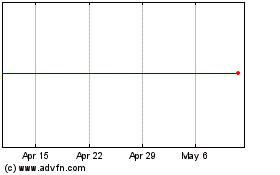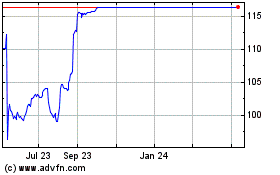-- Presentations will feature data from the
pivotal Phase 3 study of UPLIZNA, including new biomarker analyses
--
Horizon Therapeutics plc (Nasdaq: HZNP) today announced that new
UPLIZNA analyses will be presented at the 39th Congress of the
European Committee for Treatment and Research in Multiple Sclerosis
(ECTRIMS) 2023, Oct. 11-13. UPLIZNA is the first and only targeted
CD19+ B-cell-depleting therapy approved by the U.S. Food and Drug
Administration, the European Commission and the Brazilian Health
Regulatory Agency (ANVISA) for the treatment of NMOSD in adults who
are anti-aquaporin-4 immunoglobulin G seropositive (AQP4-IgG+).
Presentation Details:
- P015: Association of Cytokine Proteins with Disease Activity in
NMOSD Participants Receiving Inebilizumab Treatment (S. Pittock)
- Poster Session: Clinical aspects of MS - NMOSD
- Date: Oct. 11, 2023, 8-8:30 a.m. CEST
- P409: Long-Term Comparative Efficacy of Inebilizumab in the
AQP4+ Subpopulation from the N-MOmentum Open-Label Extension Versus
Azathioprine and Immunosuppressive Therapies and Versus Placebo in
Patients with NMOSD (B. Cree)
- Poster Session: Clinical aspects of MS - NMOSD
- Date: Oct. 11, 2023, 8-8:30 a.m. CEST
- P011: Matching-Adjusted Indirect Comparison of Current
Treatments for NMOSD and Evaluation of Long-Term Effectiveness (F.
Paul)
- Poster Session: Clinical aspects of MS - NMOSD
- Date: Oct. 11, 2023, 8-8:30 a.m. CEST
Horizon will host a symposium Thursday, Oct. 12 from 8:45 to
9:45 a.m. CEST, “Looking for unrecognized disease activity in NMOSD
to optimize treatment choice and prevent disability,” chaired by
Massimo Filippi, M.D., Ph.D., featuring presentations from Maria
Rocca, M.D., Orhan Aktas, M.D. and Jeffrey Bennett, M.D., Ph.D.
About Neuromyelitis Optica Spectrum Disorder (NMOSD)
NMOSD is a unifying term for neuromyelitis optica (NMO) and
related syndromes. NMOSD is a rare, severe, relapsing,
neuroinflammatory autoimmune disease that attacks the optic nerve,
spinal cord, brain and brain stem.1,2 Approximately 80% of all
patients with NMOSD test positive for anti-AQP4 antibodies.3
AQP4-IgG binds primarily to astrocytes in the central nervous
system and triggers an escalating immune response that results in
lesion formation and astrocyte death.4
Anti-AQP4 autoantibodies are produced by plasmablasts and some
plasma cells. These B-cell populations are central to NMOSD disease
pathogenesis, and a large proportion of these cells express CD19.5
Depletion of these CD19+ B-cells is thought to remove an important
contributor to inflammation, lesion formation and astrocyte damage.
Clinically, this damage presents as an NMOSD attack, which can
involve the optic nerve, spinal cord and brain.4,6 Loss of vision,
paralysis, loss of sensation, bladder and bowel dysfunction, nerve
pain and respiratory failure can all be manifestations of the
disease.7 Each NMOSD attack can lead to further cumulative damage
and disability.8,9 NMOSD occurs more commonly in women and may be
more common in individuals of African and Asian descent.10,11
About UPLIZNA
INDICATION
UPLIZNA is indicated for the treatment of neuromyelitis optica
spectrum disorder (NMOSD) in adult patients who are
anti-aquaporin-4 (AQP4) antibody positive.
IMPORTANT SAFETY
INFORMATION
UPLIZNA is contraindicated in patients with:
- A history of life-threatening infusion reaction to UPLIZNA
- Active hepatitis B infection
- Active or untreated latent tuberculosis
WARNINGS AND PRECAUTIONS
Infusion Reactions: UPLIZNA can cause infusion reactions,
which can include headache, nausea, somnolence, dyspnea, fever,
myalgia, rash or other symptoms. Infusion reactions were most
common with the first infusion but were also observed during
subsequent infusions. Administer pre-medication with a
corticosteroid, an antihistamine and an anti-pyretic.
Infections: The most common infections reported by
UPLIZNA-treated patients in the randomized and open-label periods
included urinary tract infection (20%), nasopharyngitis (13%),
upper respiratory tract infection (8%) and influenza (7%). Delay
UPLIZNA administration in patients with an active infection until
the infection is resolved.
Increased immunosuppressive effects are possible if combining
UPLIZNA with another immunosuppressive therapy.
The risk of Hepatitis B Virus (HBV) reactivation has been
observed with other B-cell-depleting antibodies. Perform HBV
screening in all patients before initiation of treatment with
UPLIZNA. Do not administer to patients with active hepatitis.
Although no confirmed cases of Progressive Multifocal
Leukoencephalopathy (PML) were identified in UPLIZNA clinical
trials, JC virus infection resulting in PML has been observed in
patients treated with other B-cell-depleting antibodies and other
therapies that affect immune competence. At the first sign or
symptom suggestive of PML, withhold UPLIZNA and perform an
appropriate diagnostic evaluation. Patients should be evaluated for
tuberculosis risk factors and tested for latent infection prior to
initiating UPLIZNA.
Vaccination with live-attenuated or live vaccines is not
recommended during treatment and after discontinuation, until
B-cell repletion.
Reduction in Immunoglobulins: There may be a progressive
and prolonged hypogammaglobulinemia or decline in the levels of
total and individual immunoglobulins such as immunoglobulins G and
M (IgG and IgM) with continued UPLIZNA treatment. Monitor the level
of immunoglobulins at the beginning, during, and after
discontinuation of treatment with UPLIZNA until B-cell repletion
especially in patients with opportunistic or recurrent
infections.
Fetal Risk: May cause fetal harm based on animal data.
Advise females of reproductive potential of the potential risk to a
fetus and to use an effective method of contraception during
treatment and for 6 months after stopping UPLIZNA.
Adverse Reactions: The most common adverse reactions (at
least 10% of patients treated with UPLIZNA and greater than
placebo) were urinary tract infection and arthralgia.
For additional information on UPLIZNA, please see the Full
Prescribing Information at www.UPLIZNA.com.
About Horizon
Horizon is a global biotechnology company focused on the
discovery, development and commercialization of medicines that
address critical needs for people impacted by rare, autoimmune and
severe inflammatory diseases. Our pipeline is purposeful: We apply
scientific expertise and courage to bring clinically meaningful
therapies to patients. We believe science and compassion must work
together to transform lives. For more information on how we go to
incredible lengths to impact lives, visit
www.horizontherapeutics.com and follow us on Twitter, LinkedIn,
Instagram and Facebook.
References
- Ajmera MR, Boscoe A, Mauskopf J, Candrilli SD, Levy M.
Evaluation of comorbidities and health care resource use among
patients with highly active neuromyelitis optica. J Neurol Sci.
2018;384:96-103.
- What is NMO? Accessed April 15, 2021.
Guthyjacksonfoundation.org.
www.guthyjacksonfoundation.org/neuromyelitis-optica-nmo/
- What We Know About NMO. Accessed Aug. 2, 2022.
Sumairafoundation.org.
https://www.sumairafoundation.org/what-to-know-about-nmo/
- Liu Y, et al. A tract-based diffusion study of cerebral white
matter in neuromyelitis optica reveals widespread pathological
alterations. Mult Scler. 2011;18(7):1013-1021.
- Chihara N, et al. Interleukin 6 signaling promotes
anti-aquaporin-4 autoantibody production from plasmablasts in
neuromyelitis optica. PNAS. 2011;108(9):3701-3706.
- Duan T, Smith AJ, Verkamn AS. Complement-independent bystander
injury in AQP4-IgG seropositive neuromyelitis optica produced by
antibody dependent cellular cytotoxicity. Acta Neuropathologica
Comm. 2019;7(112).
- Beekman J, et al. Neuromyelitis optica spectrum disorder:
patient experience and quality of life. Neural Neuroimmunol
Neuroinflamm. 2019;6(4):e580.
- Kimbrough DJ, et al. Treatment of neuromyelitis optica: review
and recommendations. Mult Scler Relat Disord.
2012;1(4):180-187.
- Baranello RJ, Avasarala, JR. Neuromyelitis optica spectrum
disorders with and without aquaporin 4 antibody: Characterization,
differential diagnosis, and recent advances. J Neuro Ther.
2015;1(1):9-14.
- Wingerchuk DM. Neuromyelitis optica: effect of gender. J Neurol
Sci. 2009;286(1-2):18-23.
- Flanagan EP, et al. Epidemiology of aquaporin-4 autoimmunity
and neuromyelitis optica spectrum. Ann Neurol.
2016;79(5):775-783.
View source
version on businesswire.com: https://www.businesswire.com/news/home/20231002226886/en/
Investors: Tina Ventura Senior Vice President, Chief
Investor Relations Officer
Investor-relations@horizontherapeutics.com
U.S. Media: Rachel Vann Senior Director, Product
Communications media@horizontherapeutics.com
Ireland Media: Eimear Rigby Associate Director, Corporate
Communications media@horizontherapeutics.com
Horizon Therapeutics Pub... (NASDAQ:HZNP)
Historical Stock Chart
From Oct 2024 to Nov 2024

Horizon Therapeutics Pub... (NASDAQ:HZNP)
Historical Stock Chart
From Nov 2023 to Nov 2024
